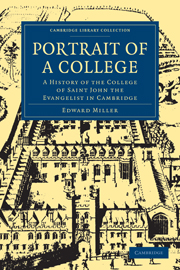III - THE UNREFORMED COLLEGE (1661–1765)
Published online by Cambridge University Press: 07 September 2010
Summary
There are striking contrasts between the history of the college in the century before the Restoration and its history in the century which followed. A period of intense movement and fundamental changes was succeeded by an epoch which, in the college as in the university, was in many respects one of stagnation. The spirit of Beale, too, triumphed over that of Lever and Whitaker. St John's came to be, very soon after the Restoration, the high Anglican and Tory college par excellence in Cambridge, a character it did not lose until well down into the nineteenth century. There is no necessary correlation between this atmosphere and a tendency towards stagnation, as was demonstrated after 1765 when Anglican and Tory sentiment proved not incompatible with academic forwardness. For a century, however, these two characteristics went hand in hand, which makes it appropriate to begin the college's post-Restoration history with some account of how new masters laid the ghosts of Arrowsmith and Tuckney.
We have already seen how old fellows restored, and new fellows intruded by the king's mandate, got rid of Anthony Tuckney. The royal supremacy also played a part in making his successor. On 18 June 1661, Charles II wrote to the fellows ‘to encourage you in those goodly thoughts you have … to make choice of … Dr Gunning’, and Dr Gunning duly became master. It was intended that he should ‘rout out the old leaven’ and ‘factious and pernicious principles’, a task for which he was well fitted.
- Type
- Chapter
- Information
- Portrait of a CollegeA History of the College of Saint John the Evangelist in Cambridge, pp. 42 - 63Publisher: Cambridge University PressPrint publication year: 2009First published in: 1961

